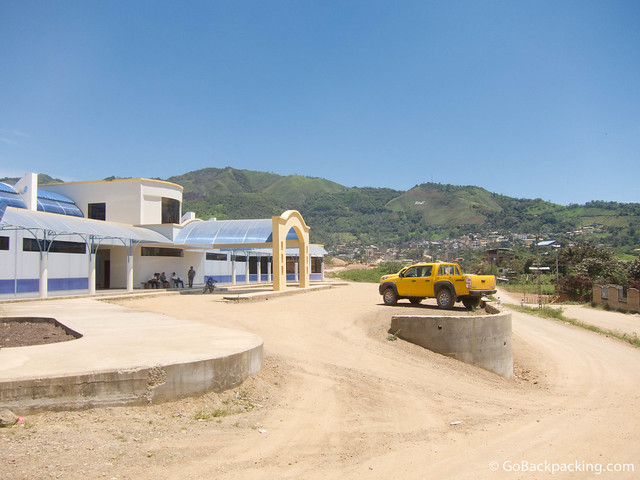
The bus station in Zumba, Ecuador
Crossing international borders overland is always a thrill, whether they be hectic and filled with hustlers out to game you, or so quiet you wonder if you're in the right place.
The longer the journey, the more remote the border, the greater the adventure.
And if given the option, I prefer to make these crossings alone, as was the case with leaving Nepal for India, and more recently, leaving Ecuador for Peru.
The following instructions are based on those provided courtesy of Hosteria Izhcayluma in Vilcabamba, Ecuador.
They were generally accurate. However, the duration of each leg of travel will vary depending on road delays and weather.
The cost will vary depending on your patience and ability to negotiate.
The information in this post is based on my experience in October 2011.
Table of Contents
- Reasons to Cross the Border at La Balsa
- Day 1, Part 1 – Vilcabamba to Zumba
- Day 1, Part 2 – Zumba to La Balsa
- Day 1, Part 3 – Crossing the Border
- Day 1, Part 4 – La Balsa to San Ignacio
- Day 1, Part 5 – Spending the Night in San Ignacio
- Day 2, Part 1 – San Ignacio to Jaen
- Day 2, Part 2 – Jaen to Bagua Grande
- Day 2, Part 3 – Bagua Grande to Chachapoyas
Reasons to Cross the Border at La Balsa
- More relaxed (i.e. few, if any hustlers) than the main crossing on the Pan American Highway
- A more direct route to Chachapoyas, and a whole region of ruins in Northern Peru
- Off the beaten track
Day 1, Part 1 – Vilcabamba to Zumba
Duration: 5 hours
Cost: $6.50
The bus from Vilcabamba to Zumba is called Cooperativa “Sur Oriente,” and it passes in front of Hosteria Izhcayluma between 6 – 6:30 AM daily.
I saw the bus rumbling up the road at 6:05 AM, held out my hand, and jumped aboard.
Ecuador's main highways are well paved, and even where they aren't, road work is underway to improve them.
Such was the case on the road leading South out of Vilcabamba toward Zumba.
There were sections of freshly laid concrete for about 45 minutes to an hour, but after that, it's all dirt roads winding up and around the mountains.
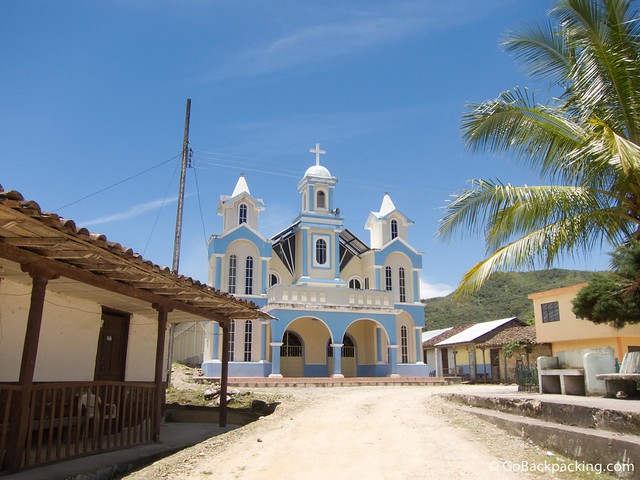
Church in Southern Ecuador
Day 1, Part 2 – Zumba to La Balsa
Duration: 1.5 hours
Cost: $1 or $2 for the local “Ranchera” bus (open-air like a chiva), or $20 for a private 4 x 4 taxi
Much to my surprise, my bus to Zumba arrived at 11 AM, which was one to two hours earlier than I'd been lead to expect.
As you can tell from the photo at the top, there's not much going on in Zumba.
I took a bathroom break, bought ice cream, and paid for a private taxi to take me to the border.
The taxi was a large, comfortable, yellow pick-up truck.
I tried to make some small talk with the driver in Spanish, but his accent made it difficult to understand him.
We were driving through the southernmost mountains of Ecuador.
It was beautiful, but at the same time, eerily remote. My mind wandered to horror movie-inspired “what if” scenarios.
I imagined how easy it would be for the driver to rob me and leave me stranded on the side of the road, or worse.
It's not that I don't know it'd be safer (and cheaper) to travel with a group of other travelers, but that's not always an option.
I wasn't going to wait around in Vilcabamba out of fear alone.
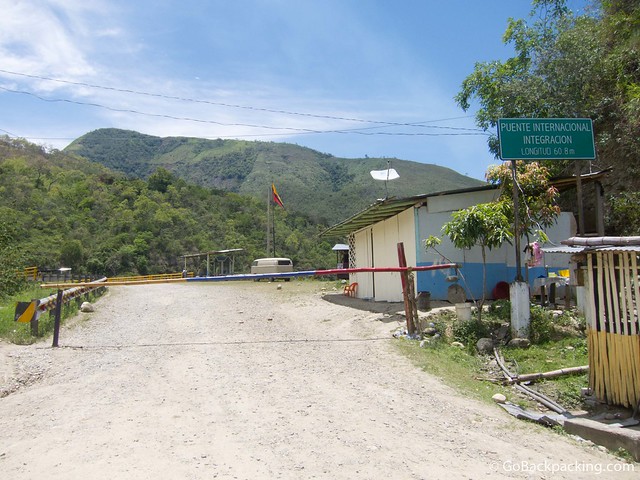
The Ecuador-Peru border at La Balsa (as viewed from Ecuadorian side)
Day 1, Part 3 – Crossing the Border
Duration: 1 hour
Cost: $0
A river marks the border between Ecuador and Peru at the La Balsa crossing.
The taxi driver stopped right in front of the Ecuador immigration office. I paid him his $20 and immediately got the exit stamp from Ecuador.
I ducked under the yellow, blue, and red-painted bamboo border gate and walked toward the bridge.
The reports from my fellow travelers were right; this was a super tranquil border crossing.
It reminded me of my border crossing from Cambodia into Southern Laos, minus the goats.
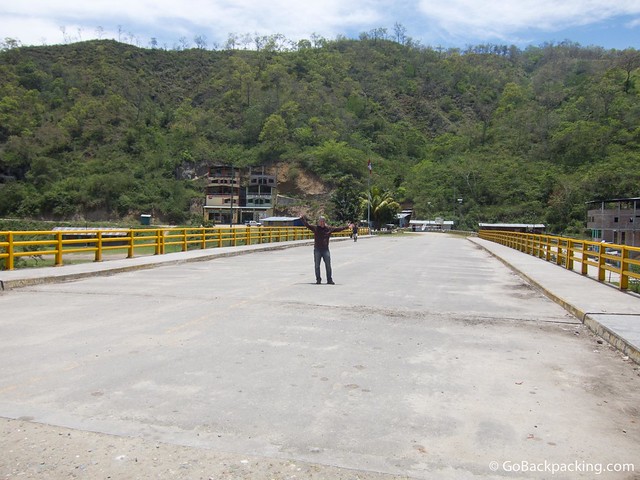
The reports are correct; the border crossing couldn't have been quieter
I approached a jovial group of guys standing under some shade on the Ecuadorian side of the bridge.
In Spanish, I asked if they could take my photo. One of them agreed, and I handed him my camera, only to see him start to run toward the bridge.
Instinctively, my heart began to pound, until I saw him stop after a few meters, and turn around with a big smile.
Of course, his friends all broke out in laughter at the joke he'd just played on the gringo.
Once on the Peruvian side, I walked into the Immigration office. Salsa music was playing on the radio.
I commented to the official how much I enjoyed salsa, and he assured me I'd hear plenty of it in Peru.
I filled out the necessary form and was instructed to walk toward a policeman who was hanging out at a nearby restaurant.
The policeman, in turn, leads me down to a little building (visible to the far left in the photo above), where he did something on a computer and instructed me to go back to the Immigration office.
The Immigration officer asked me how much time I needed in Peru. I asked for three months, he gave it to me, and I was on my way.
Day 1, Part 4 – La Balsa to San Ignacio
Duration: 1.5 hours
Cost: $5.54 total ($1.10 rickshaw + $4.44 colectivo)
I changed about $10 for Peruvian Soles with a snack vendor and then tried to negotiate with the only colectivo driver there.
I kept trying to ask how much it'd cost to San Ignacio, but he wasn't giving a clear response.
I eventually caught him smiling and winking at the snack vendor, and realized he was playing around with me.
Annoyed, I asked a rickshaw driver for help, and he explained that it's cheaper to take a colectivo from the nearby town.
He offered to take me there for 3 Soles ($1.10), which turned out to be a fair price. If I wasn't already covered in a thin film of dirt, that rickshaw ride ensured it.
As we bounced down the road, my mind once again wandered to grisly “what if” scenarios.
This time, I reminded myself that the vast majority of people in this world are honest and kind. Functional societies depend on it.
After 10 – 15 minutes, we arrived in the nearby town, and I was dropped at a corner with several white colectivo cars.
I didn't have to wait more than 10 minutes before a group of Peruvians arrived, and we piled into the car.
Two women and a child up front, and two men plus me in the back. It was comfortable until the driver stopped to pick up another woman.
Stuffing another adult into the back seat made it uncomfortable for all four of us.
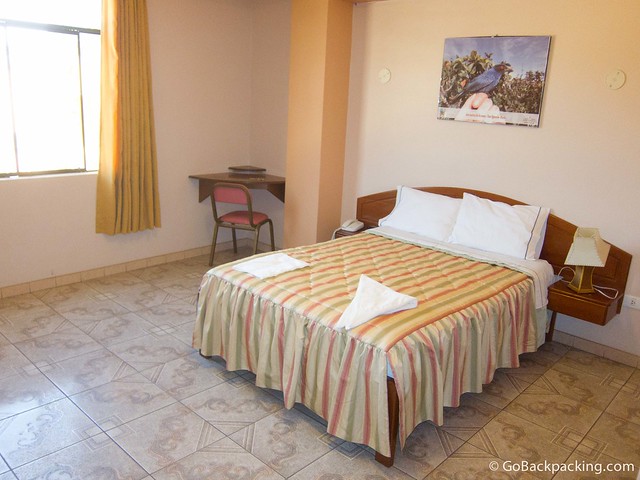
My room at the Gran Hotel in San Ignacio, Peru
Day 1, Part 5 – Spending the Night in San Ignacio
Duration: 16 hours
Cost: $18.50 private room + dinner
Eventually, we pulled into San Ignacio around 3 PM. It's a basic hill town, and there's not much to see.
My instructions had two recommendations for accommodations, Hostal “La Posada” (Basic) and “Gran Hotel.”
I opted for the Gran Hotel, which was spacious and comfortable. However, the Wi-Fi was not working at the time.
I ate dinner in the adjacent restaurant, and breakfast the following morning was included with the room.
There's a bank around the corner from Gran Hotel, but when I visited, the security guard informed me there was no ATM, or if there was, it didn't take foreign cards.
I asked if there was another place in town. Nope!
So I walked to the city center, and asked around, eventually making my way to shoe shop, that doubled as a currency exchange office.
I was already aware of the exchange rate and was surprised to get an incredibly fair price for the $130 I wanted to change.
The commission for the Peruvian woman helping me was nearly zero.
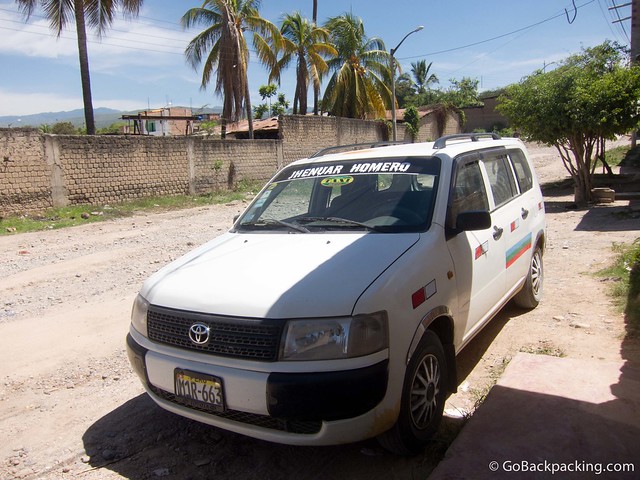
Peruvian colectivo in Bagua Grande
Day 2, Part 1 – San Ignacio to Jaen
Duration: 3 hours
Cost: $7.40
I asked the hotel to schedule me a colectivo to Jaen for 8 AM, and it arrived more or less on time.
About an hour outside of San Ignacio, the dirt roads gave way to paved asphalt for the first time since Vilcabamba.
The hotel staff had informed me Jaen was the best place to get a new SIM card for my phone.
I was anxious to get my new number and mobile internet set up, so I took the time to visit a Movistar office.
It turned out to be a complete waste of time and money. The office was busy, and I had to spend at least an hour there.
I paid for a new SIM card for my Blackberry, and pre-paid minutes for the internet, only to find out later at another Movistar office in Chachapoyas that you can only buy prepaid internet for Blackberries purchased in Peru. Mine was from the USA.
Lesson Learned: If you're destined for Chachapoyas, take care of your mobile phone needs there. Both Movistar and Claro have offices, you won't need to pay for rickshaw rides, and it's a far more relaxed environment than in Jaen.
Day 2, Part 2 – Jaen to Bagua Grande
Duration: 1 hour
Cost: $3.70
My colectivo driver for this leg played romantic Latin ballads. He was tough-looking on the outside, but a softy at heart.
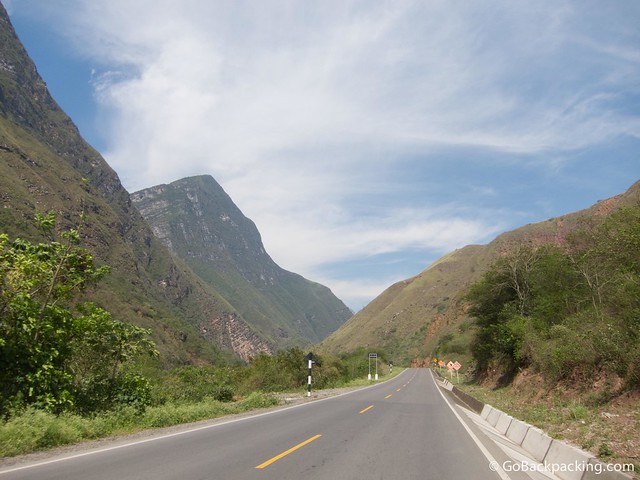
On the road from Bagua Grande to Chachapoyas
Day 2, Part 3 – Bagua Grande to Chachapoyas
Duration: 3 hours
Cost: $8.14
Bagua Grande was the first point in the two-day adventure, where I had to wait around more than a few minutes for a ride.
I left my main backpack with a colectivo and offered to pay for a second passenger if it meant a more spacious ride, and we could go sooner rather than later.
I walked to a convenience store next door to get some water and snacks. But really, I was walking int someone's house.
A young girl came out of the kitchen to help me. As I picked out my items and paid, I was being sized up by her older sister, or perhaps aunt.
But not that much older. I'd soon find out she was 21, and not at all shy. It turned out she lives in Lima but was visiting her family in Bagua Grande.
It wasn't long before she was writing down her phone number and email address for Facebook, while her mother looked on.
Flattered, I took her info and gave her my card and then left to get a proper lunch at the adjacent bus station.
About an hour later, my colectivo was heading down the final stretch to Chachapoyas, with me in the front seat.
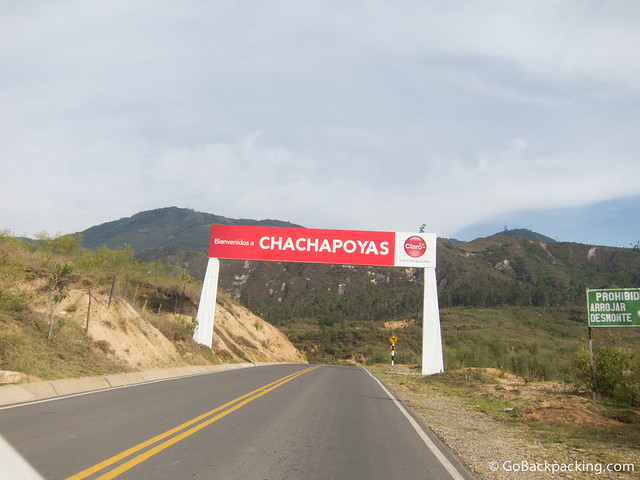
The home stretch — arriving in Chachapoyas
The colectivo pulled into Chachapoyas just as the sun was setting on day two.
Tired, and uninterested in shopping around, I took a room at Hostal Revash, which was another recommendation by the guys in Vilcabamba.
Total Cost = about $70
But it can be done for half that if:
- you're more patient than me
- take the Ranchera from Zumba
- stay at a cheap hostel in San Ignacio
Dave is the Founder and Editor in Chief of Go Backpacking and Feastio. He's been to 66 countries and lived in Colombia and Peru. Read the full story of how he became a travel blogger.
Planning a trip? Go Backpacking recommends:
- G Adventures for small group tours.
- Hostelworld for booking hostels.

Francois Tessier
Tuesday 1st of November 2016
Be careful at the border in la Balsa. I went that way in 2013, and had overstayed my visa by 10 days....it wasn't a problem, I paid the fine, they stamped my passport, and I crossed into Peru. I returned to Ecuador Oct 2016, and they didn't have my exit stamp in their system. Since I had a new passport I couldn't show them the stamp immediately. They then refused my entry, without giving me a decent amount of time to show them a picture of my old passport which was at home. After lots of bullshit, I got deported back to Canada.....very frustrating experience. The immigration officer at La Balsa must have taken the money, and not entered anything in the system....talk about corruption. I am trying to warm as many people as I can so it doesn't happen to them.
Dave
Tuesday 1st of November 2016
Sorry to hear you had to experience that and thanks for sharing what happened here.
Joakim
Sunday 16th of March 2014
Thanks a lot for this very thourogh walkthru - it really helped me getting across from Ecuador to Peru! Updates/comments for future travelers: 1. The bus you could take from Zumba to La Balza leaves at 14.30, which means you probably wouldn't get to San Ignacio anytime before 17.30. I managed to get a ride on the back of a pickup for $3, it was bumpy but added to the experience. 2. No one on the Peruvian side wanted to take me just to Namballe (6 km away, the closest town) so I had to go on a shared cab to San Ignacio. Managed to get the price down to 17 soles ($6). 3. There is now a broad, paved road all the way from the border to San Ignacio. Shorter ride, yes, but on the downside it cuts thru the hillsides in an ugly way. With that said, thanks again!
Dave
Sunday 16th of March 2014
Thanks for sharing these updates Joakim!
dan
Sunday 30th of June 2013
I'm currently living in Lima Peru and I'm interested in moving to a place here that has similar weather to vilcabamba as well as year round sun, has your experience come across such a place?
Dave
Sunday 30th of June 2013
I can't remember the weather in Vilcabamba, as I was only there a few days, but Banos, Ecuador could be nice if you prefer pueblos.
I've based myself in Medellin, which has Spring weather all year, and is surrounded by mountains. I'm comfortable in a t-shirt and jeans, day or night, all year here.
Taylor
Monday 4th of March 2013
This is invaluable - I thought the only viable (and legal) crossing options along the southern border of Ecuador were PanAmerican Highway and Macara - perhaps because I'm still in the States planning my route and not on the ground. Sounds like an adventure, thank you for taking the time to share this.
Dave
Tuesday 5th of March 2013
Glad you found it useful Taylor. While it'll take you longer, from what I heard, it's a far safer route to take.